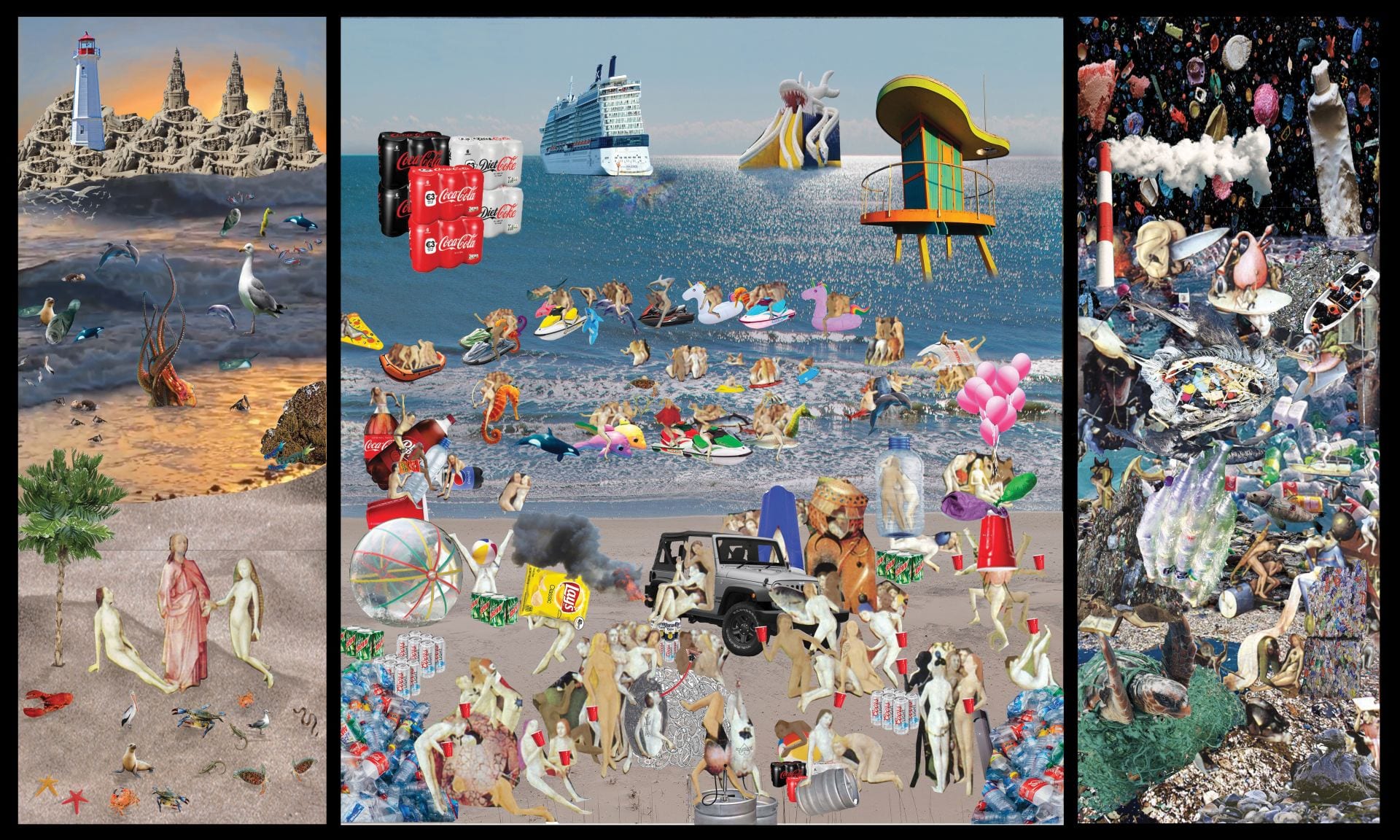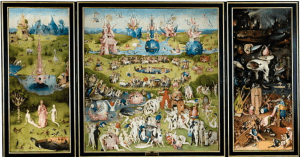Garden of Earthly Delights
Hieronymus Bosch
oil on oak panels, 220 cm × 389 cm
Museo del Prado, Madrid
Sofia Guastella, Signe Healy
We have chosen to remake the piece Garden of Earthly Delights by Hieronymus Bosch. This work is an oil on panel triptych displayed in the palace of the counts of Nassau in Brussels (considered commissioned because of location even though it was not). The piece viewers for its absurdity and vulgar depictions of humans. It depicts 4 scenes. The scene when the triptych is closed is God looking down on his creation, Earth. When opened, the left side panel depicts Adam, Eve, and God in the Garden of Eden. This shows the tranquil and perfected Earth, even if it is an imagined scene with fictitious animals. The middle panel depicts Earth with many humans engaging in almost sinful acts. No one has yet sinned but the intent is implied with the devious nature of humans clearly displayed by the artist. The final panel in the series (right) depicts Hell with a mutant bird satan eating humans and all the humans being punished according to their implied sin. This panel is meant to be a warning reminder to the worshipers in the palace of what happens in Hell after sinning.
The piece was remade twice shortly after the artists death, once as a painting and once as a tapestry, and then many other times since then. Signe, my partner for this project, has been fascinated with this painting since first seeing it, thinking it was beautifully whimsical and terrifying. Appealing to my prevalent whimsical side, she loved it and the dark warning message the artist communicates.
We decided to take this warning message and turn it into something relevant to today’s society. We believe that the idea of preservation of our oceans is a very pressing issue and we want to address it in our remake of this work. The medium of our work is going to be only non-toxic biodegradable materials like paper and wood, or we will compile found trash. Our current idea is to use photoshop to recreate the landscape, figures, and thematic elements to focus on ocean pollution specifically plastic pollution. The left panel would be a perfectly clear ocean, beach and garden. The middle will be a beach party, inspired by spring break and senior beach weeks, where many youths party at the beach drinking out of solo cups and littering on the beach. The right panel will be the aftermath of this liter, killing the fish and animals in the ocean. This piece will be attached to the wall and the three sheets of paper are going to be positioned one next to the other.
At first, one of our ideas was to contextualize the concept of the ocean more than a garden, in order to create a remake without appropriating the whole idea. One of the other ideas was to create a mask out of papier maché in order to symbolize the good and the evil of the men from outside to inside. We have now developed a new idea which relates more to the message and the symbolism of the artwork. Which is the following:

First (left) : Idyllic picture, nature flourishing, beach and garden perfectly kept, no sign of pollution. Garden of Eden
Second (middle): Party, loads of people, careless and polluting, picture representing today’s society, people not caring. Sinning
Third: Much darker colors, animals trapped and killed. Dead nature. Hell
Art Research Books
The topic for our Art researches were: On the object of our remake, on other remakes of our artwork and on artists that use research for their art.
What historical research we conducted:
We researched the history of the painting and the artist in depth, every little symbolism was researched and was linked to what we included in the artwork. We did art research on two different remakes of the work. One is Carolyn Janssen, an artist who re-made the artwork using only portraits of herself in order to give an intense femininity to the artwork, also relating it to today’s pop culture. We were also inspired by the work of Carla Gannis, a digital artist who has re-made this artwork entirely using emojis, which is also a strong modernization to this piece that we want to achieve with our work. The amount of research that we have conducted and the countless times that we changed our ideas and exchanged points of views with each other is something that will be of use to us in our future works. We also heard a talk from one of Lina Hentgen, from the artistic duo Hippolyte Hentgen, which helped us a lot in figuring out how to work cohesively in a couple. I believe we both perfected our skills in digital working, for example photoshop, and very much improved in collaboration and team work.
A Contemporary Garden of Delights (2015)
Carolyn Janssen, American artist that remade the piece using portraits of herself. She wanted to emphasize gender roles in the painting by feminizing every character with an outlook on pop culture. She re-contextualized the artwork
“I would step back, peer through the ruckus, and appreciate the ways in which The Garden of Earthly Delights tells us what we want it to. In many ways it’s a mirror of our own desires and longings.” – C. Janssen
The Garden of Emoji Delights (2013)
Carla Gannis, american digital artist that remade the piece entirely using emojis.
” Gannis reconstructs Hieronymus Bosch’s famous triptych for the digital era, while redefining identity and its forms of representation, both virtually and physically. She replaces the religious elements of the triptych with contemporary symbols, otherwise known as emojis. This digital collage explores modern society by using popular iconography in today’s world. Gannis chooses symbols that are popular and widely used today, which compares to the religious symbols that were prevalent in society when the original artwork was created. ” – from Art website Anti Utopias
Both of these female artists incorporated digital culture into the piece, which is what we are doing as well.
The interpretation of symbolism
We put a special emphasis on the symbolism and imagery conveyed in the original artwork. We kept the original images and re-contextualized them in scenes that can be seen in 2018. In the first slide, we kept the figures of God, Adam and Eve and placed them into an idyllic beach. In the second slide, we modified some of the figure’s skin tones and added tattoos in order for them to look more actual and diverse.
(middle)
(middle)
(middle)
We have paid close attention to replacing the figures with similar versions, for example: the egg like figure replaced by the famous image of the bird’s carcass full of plastic
Other example: the fountain in the garden of Eden was replaced by a kraken.
How we replaced the fauna in the Garden of Eden
Symbolism: King Herod and the Massacre of the innocents (new testament) refers to the bible’s parabola of King Herod and its place in hell, we replaced the throne with a two plastic squares.
Development:
Our photoshop skills greatly improved during this project, I personally learned how to balance colors for them to all look blended and similar. Signe worked many hours on layering and cutting objects, as well as learning how to warping them.
Installation sketches:
Our installation consisted in three panels of black foam paper connected by four hinges that permitted the panels to open and close.
Installation pictures in detail:
How to look at the work, how to experience it and how to interact with it:
The work is going to be on the wall, it’s a triptych that connects with hinges, meaning that it can open and close. The audience will be free to interact with the work as long as they like. There will be content both on the inside and outside of the work. The two sides of the triptych are going to close and become one only slide.
Explain: how the work relates to the class project (or personal project)
This will be a clear remake of Garden of Earthly Delights by Bosch in terms of: structure, content and concept. What we are changing and making our own is the context of the message, relating it to modern times. Bosch created this work to show the sins of humanity in his religious beliefs during the Renaissance, we are showing the sins of humanity from our point of view, today in 2018. The structure remains intact to perfection, the dimensions will be in scale from the artwork (with certainly reduced dimension) as the two sides have to form the half of the middle panel. The content as for the painted human figures are going to remain untouched, while what surrounds them is going to be distorted and changed into today’s reality.
What meaning, emotion or experiences we wanted to induce:
We want the audience to know that this is a strong social message that we are giving. We are giving our own perspective of how the message conveyed in the artwork during the Renaissance applies to today’s culture. And today’s culture’s version is waste and total carelessness of nature and how the advance of consumerism brought to the outcome that we have in our oceans. Our current society is based on mass production, what we don’t realize is that we have very little time to fix the problems that we have created. We want to induce indignation and anger as well as ignite a reaction on the viewer, make the viewer re-think their choices. The way this artwork was structure gives the viewer a clear time line of events, it starts from idyll, to progression of sinning, the influence of men on the earth and then it gives the outcome as the most disastrous scenario.























